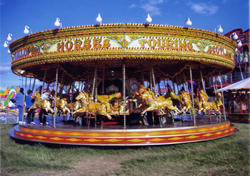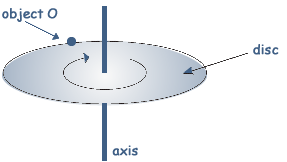Circular Motion - Multiple choice Q1. A young child of mass 20 kg stands at the centre of a uniform horizontal platform which rotates at a constant angular speed of 3.0 rad s–1. The child begins to walk radially outwards towards the edge of the platform. The maximum frictional force between the child and the platform is 200 N. What is the maximum distance from the centre of the platform to which the child could walk without the risk of slipping?
Q2. A model car moves in a circular path of radius 0.8 m at an angular speed of
What is its displacement from point P, 6.0 s after passing P?
Q3, What is the value of the angular velocity of a point on the surface of the Earth?
Q4. A mass on the end of a string is whirled round in a horizontal circle at increasing speed until the string breaks. The subsequent path taken by the mass is:
Q5. A particle of mass m moves in a circle of radius r at uniform speed, taking time T for each revolution. What is the kinetic energy of the particle?
Q6. The diagram shows a disc of diameter 120 mm that can turn about an axis through its centre. The disc is turned through an angle of 30° in 20 ms. What is the average speed of a point on the edge of the disc during this time?
Q7. For a particle moving in a circle with uniform speed, which one of the following statements is correct?
Q8. A particle travels at a constant speed around a circle of radius r with centripetal acceleration a. What is the time taken for ten complete rotations?
Q9. The wheel of the London Eye has a diameter of 130 m and can rotate at a steady speed, completing one rotation every 30 minutes. What is the centripetal acceleration of a person in a capsule at the rim?
Q10. A small mass is placed at P on a horizontal disc which has centre O. The disc rotates anti-clockwise about a vertical axis through O with constant angular speed.
Which one of the following describes the force which keeps the mass at rest relative to the disc?
Q11. A fairground roundabout makes nine revolutions in one minute. What is the angular speed of the roundabout?
Q12. The figure shows a smooth thin tube T through which passes a string with masses m and M attached to its ends. Initially the tube is moved so that the mass, m, travels in a horizontal circle of constant radius r, at constant speed, v. Which one of the following expressions is equal to M?
Q13. What is the angular speed of a point on the Earth's equator?
Q14. For a particle moving in a circle with uniform speed, which one of the following statements is correct?
Q15. An object moving at constant speed in a circle experiences a force that is
Q16. A ball of mass m, which is fixed to the end of a light string of length l, is released from rest at X. It swings in a circular path, passing through the lowest point Y at speed v.
If the tension in the string at Y is T, which one of the following equations represents a correct application of Newton's laws of motion to the ball at Y?
Q17. A disc of diameter D is turning at a steady angular speed at frequency f about an axis through its centre.
What is the centripetal force on a small object O of mass m on the perimeter of the disc?
Q18. What is the angular speed of a car wheel of diameter 0.400 m when the speed of the car
is 108kmh–1 ?
|
Follow me...
|















